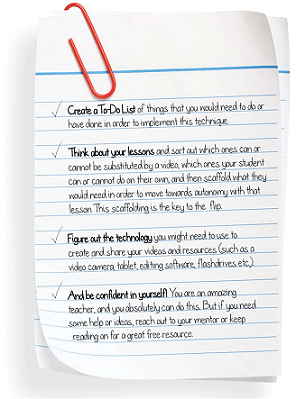Jump-start Your Teaching by Flipping the Classroom
Timothy Huneycutt |
September 13, 2013
We know that one of the greatest challenges you, as a teacher, face in the classroom is trying to teach your students new concepts and high-level ideas. Some students pick them up almost immediately, and other students struggle every step of the way. And sometimes, no matter what the classroom experience might be, no matter how well you think they will do on their homework that covers exactly what you showed them in class, you will have a student who returns the next day with a forlorn face, a blank assignment, and the go-to excuse of “it made sense when you did it!”
This scenario – and others like it – happen all the time, and while it is unfortunate, it’s important to know that you are not alone. Learning new things can be difficult, sometimes even frustrating for students, and it is up to you, the teacher, to make sure the learning process goes as smoothly as possible – and that’s where flipping your classroom comes into play!
For this post, we contacted our science coordinator and expert “classroom flipper,” Robert Gonzales, who has graciously provided some insight into what he believes flipping the classroom means, what it should look like, and how you can flip your own classroom.
What is a flipped classroom? According to Robert, it’s not a thing, it’s an action. In his own words, flipping the classroom is “changing the instructional approach to provide appropriate resources for students at home in order to capitalize on critical thinking opportunities only available within the social construct of the classroom.”
When you flip your classroom, you can:
◾Promote student accountability and ensure reasonable, realistic work that your students can handle during the preliminary acquisition of content knowledge.
◾Protect more class time for meaningful student/teacher and student/student interactions, and establish a climate of student success and support in an abstract, technical course.
◾Support students who are absent from the class for school-related purposes or otherwise, and make your teaching public to an audience larger than your students (including parents and fellow educators).

And you do all of this through the creation of supplemental instructional videos – but don’t freak out! You don’t have to be a technical guru to do this, nor do you need to record exhaustive lectures for your students. Any video you create should be short, sweet, and to the point. Effective videos should be no more than 5 minutes long.
“The big idea behind a flipped classroom is giving students access to the fundamentals of your content, in a way that allows them to prepare for critical thinking successfully AND independently," says Robert. Since the critical thinking is meant to occur with teacher guidance and support IN the classroom, the content of the video does not need to explore the depths of a subject, but instead introduce students to academic vocabulary and help them make connections.”
To put it another way, flipping the classroom provides your students a way to establish a baseline foundation of knowledge at home by introducing them to new ideas – or reinforcing old concepts that they need to remember. When your students return to the classroom, then you can help them start assembling the more complex ideas and applications that they might otherwise get frustrated with on their own. In a flipped classroom, you are more than just a lecturer of numbers and facts; you are a facilitator of growth and knowledge.
Now you know what flipping the classroom is and the major benefits it can have for your students, but how do you do it?
Here are a few sample NMSI lessons you can start using now. And, if you need additional support, Robert Gonzalez has a great resource you can use.
As you can see, flipping the classroom does take some work, but it is a practice that will radically change your perspective as a teacher and the lives of your students. Classroom learning should be an exciting time of creating knowledge and building ideas with your students, and flipping your classroom can do exactly that.
And for those of you in Texas who want to learn more about flipping your classroom along with other strategies, we will be hosting in-house STAAR trainings this fall. Our master teacher trainers are experts at flipping the classroom, specifically in the subjects of math and science, and you can catch Robert leading some of the sessions. It’s not too late to register, but seats are filling up fast.
Join the movement to flip your classroom today!